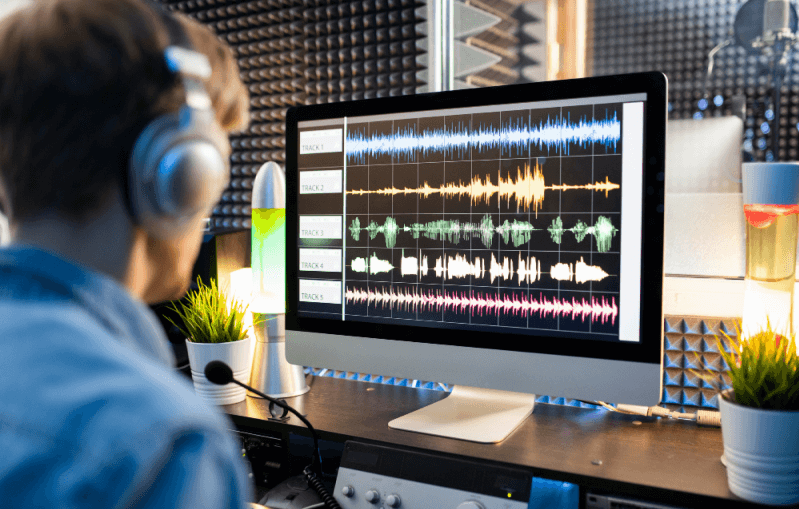A comprehensive overview to audio visual charlotte nc for organizers
Wiki Article
Comprehending the Addition of Audio Visual Innovation in Today's Educational Environments
The combination of audio-visual innovation in academic settings has changed the teaching and finding out process. Educators now have access to tools that satisfy various learning styles, boosting student engagement and cooperation. Nonetheless, the consolidation of these technologies offers both opportunities and obstacles. Recognizing exactly how to properly implement these devices is crucial. What strategies can instructors employ to make best use of the advantages of audio-visual modern technology in their class?The Development of Audio-Visual Modern Technology in Education And Learning
As educational needs evolved over the decades, audio-visual technology went through substantial transformations that reshaped the understanding setting. Tools such as film projectors and slide shows were the main methods of integrating aesthetic elements right into classrooms. These early technologies offered educators with the capability to existing information dynamically, yet they were restricted in ease of access and interactivity.With the introduction of videotape recorder in the 1970s, class started to incorporate recorded lessons, widening the range of educational sources. The introduction of computers in the 1980s additional reinvented this landscape, enabling the production of multimedia presentations and interactive discovering experiences.
The increase of the net in the 1990s noted a turning point, making it possible for real-time accessibility to a wide range of audio-visual products. Today, digital tools such as interactive white boards and online learning systems proceed to improve the academic experience, promoting interaction and cooperation amongst students.
Benefits of Audio-Visual Tools for Diverse Knowing Styles
Audio-visual devices play an essential function in accommodating diverse discovering designs by enhancing visual knowing and enhancing acoustic interaction. By including photos, videos, and sound, these innovations develop an even more inclusive educational atmosphere. This diverse technique allows instructors to address the varied preferences and requirements of students successfully.Enhancing Visual Discovering
Interaction in the knowing process is substantially boosted via using audio-visual devices, dealing with various finding out designs. These devices, such as video clips, infographics, and interactive presentations, provide aesthetic stimulations that assist understanding and retention. Visual learners, specifically, gain from the unification of pictures and computer animations, which can simplify complicated ideas and boost understanding. In addition, audio-visual resources can illustrate real-world applications, making discovering more relevant and appealing. By incorporating color, motion, and noise, teachers can create a vibrant learning atmosphere that captures pupils' attention and cultivates deeper cognitive links. Inevitably, the strategic usage of audio-visual technology not only supports aesthetic discovering however additionally enriches the general academic experience for diverse learners.Improving Auditory Engagement
A significant benefit of integrating audio-visual devices in education is their ability to enhance acoustic involvement among trainees. These tools, which incorporate multimedia presentations, podcasts, and interactive audio elements, satisfy different discovering styles, especially benefiting auditory students (audio visual charlotte nc). By integrating audio and narration, teachers can develop immersive experiences that capture students' focus and strengthen understanding. This engagement is crucial, as it fosters a deeper understanding of the product and promotes retention. Additionally, audio-visual tools can assist in joint learning environments, urging students to take part in conversations and share their understandings. Eventually, the incorporation of audio-visual technology not only supports auditory engagement yet additionally enhances the overall academic experience, making finding out more vibrant and reliable for all studentsEnhancing Involvement Via Interactive Learning

Additionally, gamification aspects, such as quizzes and simulations, can boost inspiration and retention, making discovering more enjoyable and reliable. These approaches not only stimulate cognitive involvement however also cater to varied understanding designs, ensuring that all pupils can participate meaningfully. Consequently, interactive understanding environments foster a feeling of community and belonging, ultimately resulting in improved scholastic results. With the integration of audio aesthetic technology, educators can change typical class right into vivid rooms where trainees thrive and actively form their academic journeys.
Connecting Theory and Experiment Multimedia Resources
Multimedia resources act as a vital link in between theoretical ideas and practical application in instructional setups. By boosting involvement, facilitating joint knowing experiences, and supporting varied understanding styles, these tools create a much more comprehensive and vibrant learning environment - audio visual charlotte nc. This technique not just cultivates much deeper understanding however likewise prepares students for real-world challenges
Enhancing Engagement With Multimedia
Involvement in instructional setups greatly increases when teachers go to website integrate multimedia resources right into their training techniques. The usage of videos, podcasts, and interactive presentations enhances the learning experience, allowing pupils to connect with the material on numerous degrees. Multimedia sources cater to different discovering designs, supplying aesthetic, acoustic, and kinesthetic stimulations that can hold pupils' focus much more efficiently than conventional lecture methods. Additionally, these sources can simplify complex concepts, making them more easily accessible and memorable. By incorporating multimedia, instructors can develop a dynamic class setting that cultivates interest and encourages learners. Ultimately, the tactical usage of audio-visual modern technology offers to connect the void between academic knowledge and practical application, improving the instructional experience for both trainers and students.Promoting Collaborative Discovering Knowledge
Countless researches suggest that joint knowing experiences considerably improve pupil outcomes when integrated with multimedia resources. Multimedia tools help with interaction among trainees, permitting them to engage in analytic and important assuming jointly. By utilizing video conferencing, collective platforms, and interactive presentations, educators create atmospheres helpful to synergy and shared knowing. These modern technologies make it possible for students to communicate their ideas successfully and obtain immediate comments, cultivating a deeper understanding of the subject. Additionally, multimedia resources can present complicated principles in more digestible styles, advertising conversation and collaboration. Consequently, the combination of collective discovering and audio-visual innovation not only improves the academic experience but likewise prepares trainees for real-world team effort characteristics, stressing the significance of participation and collective knowledge building and construction.Sustaining Diverse Discovering Styles
While traditional training techniques frequently cater to a minimal series of finding out preferences, the integration of audio-visual technology supplies an extra inclusive approach to education. By using multimedia sources such as videos, interactive simulations, and digital discussions, educators can resolve different discovering styles, including visual, acoustic, and kinesthetic. This adaptability permits separated direction, allowing students to engage with web content in manner ins which resonate with their individual choices. In addition, audio-visual tools can assist in deeper understanding by supplying multiple depictions of complex principles. Therefore, pupils who might battle with standard techniques can discover different pathways to success, fostering an extra fair knowing setting that supports academic success for all learners.Challenges in Applying Audio-Visual Modern Technology
Audio-visual technology holds wonderful assurance for click here for more info boosting academic experiences, its implementation commonly encounters considerable obstacles. One key issue is the financial burden associated with acquiring and preserving such devices, which can strain budget plans, especially in underfunded organizations. Additionally, insufficient training for instructors can prevent effective assimilation, leaving them ill-prepared to make use of the technology completely. Technical concerns, such as software malfunctions and compatibility issues, might additionally disrupt lessons and annoy both educators and pupils. Furthermore, differing degrees of student access to technology outside the classroom can develop disparities in finding out possibilities. Finally, the possibility for over-reliance on technology might interfere with important teaching approaches, eventually limiting the instructional experience. Attending to these obstacles requires a comprehensive technique, consisting of appropriate funding, expert growth, and equitable access to sources, to ensure that audio-visual technology can be leveraged properly in today's academic setups.Best Practices for Integrating Modern Technology in the Classroom

Additionally, fostering an interactive setting via collaborative devices motivates trainee engagement and involvement. Using diverse audio-visual sources caters to different learning designs, accommodating aesthetic, auditory, and kinesthetic learners. On a regular basis evaluating the influence of technology on pupil knowing assists instructors fine-tune their methods and adapt to changing requirements. Finally, involving students in the choice of innovation advertises ownership and inspiration. By adhering to these best techniques, teachers can create a dynamic class ambience that efficiently integrates innovation and enhances the instructional experience for all trainees.
The Future of Audio-Visual Modern Technology in Education And Learning
As classrooms significantly embrace technology, the landscape of audio-visual devices in education and learning remains to progress (audio visual charlotte nc). Future developments are anticipated to concentrate on higher interactivity and customization, allowing teachers to tailor finding out experiences to private student needs. Innovations such as augmented truth (AR) and online truth (VR) will likely offer immersive learning environments, enhancing pupil involvement and understanding
Man-made knowledge (AI) is poised to play a significant duty in audio-visual modern technology by providing real-time responses and flexible discovering paths. This integration may help teachers identify and resolve trainee challenges extra properly. Cloud-based platforms will certainly help with less complicated access to resources and collaboration amongst pupils and teachers, regardless of area.
Along with these technical advancements, expert advancement for instructors will certainly be essential, ensuring they are equipped to make use of these devices effectively. Generally, the future of audio-visual modern technology in education assures to find this produce more vibrant, inclusive, and impactful understanding experiences.
Often Asked Inquiries
Exactly How Can Educators Pick the Right Audio-Visual Equipment for Their Classrooms?
Picking ideal audio-visual devices requires instructors to analyze their educational objectives, take into consideration trainee needs, assess available technology, and seek referrals from peers or specialists, ensuring devices efficiently improve discovering and engagement within their specific classroom environment.What Spending plan Considerations Are There for Carrying Out Audio-Visual Modern Technology?
Budget plan considerations for applying audio-visual innovation include initial purchase costs, upkeep expenses, training for staff, and possible software application licensing charges. Furthermore, long-term financial investment in updates and replacements must likewise be factored into financial preparation.Exist Particular Training Resources for Teachers on Audio-Visual Tools?
Numerous institutions provide training sources for educators on audio-visual devices, consisting of on-line courses, workshops, and educational overviews. These resources aim to enhance educators' abilities and confidence in efficiently integrating technology into their teaching techniques.How Do We Determine the Effectiveness of Audio-Visual Modern Technology in Knowing?
Gauging the efficiency of audio-visual innovation in learning includes examining student engagement, understanding, retention rates, and overall academic efficiency. Surveys, assessments, and observational studies can offer important understandings right into its influence on instructional results.What Prevail Misconceptions About Audio-Visual Innovation in Education?
Typical mistaken beliefs regarding audio-visual technology in education and learning include the belief that it assures engagement and discovering results, as well as the presumption that all students benefit equally, overlooking individual understanding choices and requirements.Report this wiki page